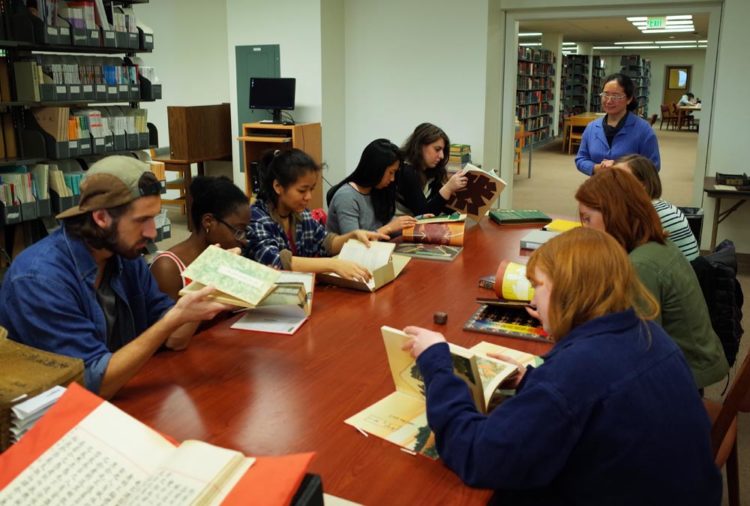Asian Library
The Asian Library of The Claremont Colleges is a distinguished library within the Claremont Colleges Library. We support The Claremont Colleges’ curricula in the arts & humanities, social sciences, STEM, and language studies focused on Asia.
A distinguished library within The Claremont Colleges Library, the Asian Library supports The Claremont Colleges’ curricula in the arts & humanities, social sciences, STEM, and language studies focused on Asia. Noted for our holdings of rare books, manuscripts, and artifacts from China, Japan, and Korea, we aim to strengthen and support the growth of Asian Studies at The Claremont Colleges by broadening our collecting efforts to include South, Southeast, and Western Asia, and by collaborating with faculty on expanding and improving our instruction and research services and physical spaces within the library.

Building on the strengths of our historical collections, we acquire new materials in print and digital formats published in and outside of Asia to support faculty’s research in Asian studies. We collaborate with faculty members to develop assignments that allow students to engage with relevant library materials in their course work, to host classes where students directly engage with librarians and resources relevant to their course topic, and to create customized guides to support research, teaching, and learning in Asian Studies.
The Claremont Colleges Library is a partner with EnviroLab Asia, a 5-C intercollegiate initiative funded by the Henry Luce Foundation to study environmental issues in East and Southeast Asia from perspectives of humanities, social sciences, and environmental analysis. The library actively participates in EnviroLab Asia activities and events, and acquire relevant print and electronic resources to support EnviroLab Asia research activities, classes and field trips to selected Asian countries.
Research Guides:
Environmental Resources on Thailand and Southeast Asia
Environmental Resources on Japan
New Databases:
DBpia: Korean scholarly journals in arts and humanities, social sciences, and STEM fields.
Asahi Shimbun Cross-Search: Full text of Asahi Shimbun, from its first edition in 1879 (Meiji 12) to today; Shukan Asahi, AERA, 1985 to present; Asahi Shimbun Reduced-size facsimile edition, 1945-1999.
Among the many rare collections held in the Asian Library are correspondence, manuscripts and historical photos; Buddhist sutras and artifacts; Japanese and Korean maps; Chinese rare books of history, literature, local gazetteers; early Chinese translations of the Bible, western science and technology books, and other print publications. All of our rare collections are available for research and study by students, faculty, and staff of The Claremont Colleges and by the wider scholarly community.
Some of the Asian Studies special collections have been digitized for online access by users of The Claremont Colleges and beyond. They range from Japanese traditional woodblock prints, Korean rare books, Chinese political posters, to oral history interviews on key figures of the American occupation government in postwar Japan.
There are several artifact collections at the Asian Library and Special Collections. They are good examples for classes highlighting Asian civilization, history, and material cultures. Please contact us for more information on how to make them available for your teaching and learning.
The Asian Library Special Collections is enriched by four rather rare items. One is a Northern Song dynasty Buddhism sutra named 央掘魔羅經 (Yang jue mo luo jing), printed on woodblock in 1090 and representing the first ever sutra binding in Chinese printing history. The second is a late Yuan dynasty book on medical science, 素問入式運氣論奧 (Su wen ru shi yun qi lun ao), in two volumes with a preface dated 1099, printed circa 1339. The third are two incomplete sets of Chinese classics, 春秋屬辭 (Chun qiu shu ci) and 春秋師說 (Chun qiu shi shuo), woodblock printed in 1364. The fourth is a manuscript set of the“Four Classics” with illustrations, 欽定四書圖説 (Qin ding si shu tu shuo) and amounts to nineteen stitched volumes bound in yellow silk covers and protected by four yellow silk covered cases. This handwritten copy is accompanied by illustrations drawn by hand and is the only copy in the United States and possibly the world.

央掘魔羅經 (Yang jue mo luo jing), the Chinese translation of Aṅgulimālīya Sūtra, is part of the Chinese Buddhist canon known as the Chongning Wanshou Tripitaka 崇寧万壽大藏. Woodblock printed in 1090, it represents the first ever sutra binding in Chinese printing history.

素問入式運氣論奥 (Su wen ru shi yun qi lun ao), by 劉溫舒 (Liu Wenshu), printed on woodblock circa 1339, is a discussion of the mysteries of circuits of Qi, modeled after 黃帝內經素問 (Huangdi neijing suwen) or “The Yellow Emperor’s inner canon: Plain Questions.”

春秋屬辭十五卷 (Chun qiu shu ci),春秋師說上、下 (Chun qiu shi shuo). These two books are studies and authoritative interpretations on the Spring and Autumn Annals, the first Chinese chronological history. Woodblock printed in 1364, in the last year of Zhizheng reign of the Yuan dynasty, and stamped with seals of 嘉業堂 (Jiayetang), the library and publishing house of 劉承幹 (Liu Chenggan, 1882–1963) in 湖州 (Huzhou), China.

欽定四書圖說 (Qin ding si shu tu shuo), an illustrated manuscript set of the “Four Classics” on Confucian core value and belief systems: 《論語》 (Analects)、《孟子》 (Mencius)、《大學》 (Great Learning)、《中庸》 (Doctrine of the Mean). Written upon imperial order of the Qing emperor Guangxu toward the end of his reign (1904–06), it took two years to produce two copies. One was submitted to the throne (later destroyed in the palace fire), and the other is here in The Claremont Colleges Library, which now holds the only copy of the book worldwide.